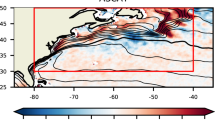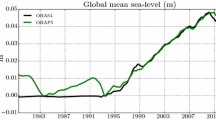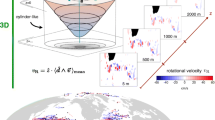Abstract
Series of sensitivity tests were performed with a z-coordinate, global eddy-permitting (1/4°) ocean/sea-ice model (the ORCA-R025 model configuration developed for the DRAKKAR project) to carefully evaluate the impact of recent state-of-the-art numerical schemes on model solutions. The combination of an energy–enstrophy conserving (EEN) scheme for momentum advection with a partial step (PS) representation of the bottom topography yields significant improvements in the mean circulation. Well known biases in the representation of western boundary currents, such as in the Atlantic the detachment of the Gulf Stream, the path of the North Atlantic Current, the location of the Confluence, and the strength of the Zapiola Eddy in the south Atlantic, are partly corrected. Similar improvements are found in the Pacific, Indian, and Southern Oceans, and characteristics of the mean flow are generally much closer to observations. Comparisons with other state-of-the-art models show that the ORCA-R025 configuration generally performs better at similar resolution. In addition, the model solution is often comparable to solutions obtained at 1/6 or 1/10° resolution in some aspects concerning mean flow patterns and distribution of eddy kinetic energy. Although the reasons for these improvements are not analyzed in detail in this paper, evidence is shown that the combination of EEN with PS reduces numerical noise near the bottom, which is likely to affect current–topography interactions in a systematic way. We conclude that significant corrections of the mean biases presently seen in general circulation model solutions at eddy-permitting resolution can still be expected from the development of numerical methods, which represent an alternative to increasing resolution.


















Similar content being viewed by others
Notes
NEMO: Nucleus for European Models of the Ocean.
MERCATOR-Ocean: http://www.mercator-ocean.fr.
Institut du Développement et des Ressources en Informatique Scientifique, Orsay, France.
References
Adcroft A, Hill C, Marshall J (1997) Representation of topography by shaved cells in a height coordinate ocean model. Mon Weather Rev 125:2293–2315
Arakawa A, Lamb VR (1981) A potential enstrophy and energy conserving scheme for the shallow water equations. Mon Weather Rev 109:18–36
Barnier B, Le Provost C (1993) Influence of bottom topography roughness on the jet and inertial recirculation of a mid-latitude gyre. Dyn Atmos Oceans 18:29–65
Beckmann A, Döscher R (1997) A method for improved representation of dense water spreading over topography in geopotential-coordinate models. J Phys Oceanogr 27:581–591
Berliand ME, Strokina TG (1980) Global distribution of the total amount of clouds. Hydrometeorological, Leningrad, p 71 (in Russian)
Biastoch A, Krauss W (1999) The role of mesoscale eddies in the source regions of the Agulhas current. J Phys Oceanogr 29:2303–2317
Blanke B, Delecluse P (1993) Variability of the tropical Atlantic Ocean simulated by a general circulation model with two different mixed-layer physics. J Phys Oceanogr 23:1363–1388
Blayo E, Le Provost C (1993) Performance of the capacitance matrix method for solving Helmholtz type equations in ocean modelling. J Comp Physiol 104:347–360
Boebel O, Davis RE, Ollitrault M, Peterson RG, Richardson PL, Schmid C, Zenk W (1999) The intermediate depth circulation of the western South Atlantic. Geophys Res Lett 26(21):3329–3332
Böning CW, Bryan FO (1996) Large-scale transport processes in high resolution circulation models. In: Borntraeger G (ed) The warm watersphere of the North Atlantic. Berlin, pp 91–128
Böning CW, Rhein M, Dengg MJ, Dorow C (2003) Modeling CFC inventories and formation rates of Labrador Sea Water. Geophys Res Lett 30(2):1050. DOI 10.1029/2002GL014855
Bryan FO, Holland WR (1989) A high resolution model of the wind- and thermohaline-driven circulation in the North Atlantic Ocean. In: Muller P, Henderson D (eds) Aha Huliko’a parameterization of small-scale processes. Hawaii Institute of Geophysics, Hawaii, pp 99–115
CERSAT (2002) Mean wind fields (MWF product), vol. 1. In: ERS-1, ERS-2 & NSCAT user manual. Ref C2-MUT-W-05-IF, version 1.0
Coward AC, de Cuevas BA (2005) The OCCAM 66 level model: model description, physics, initial conditions and external forcing. Southampton Oceanography Centre internal document 99, Southampton, UK, p 83
Czeschel L (2005) The role of eddies for the deep water formation in the Labrador Sea. Ph.D. thesis, Kiel University, Institut f. Meereswissenschaften, p 101
de Miranda A, Barnier B, Dewar WK (1999a) On the dynamics of the Zapiola anticyclone. J Geophys Res Ocean 104:21137–21149
de Miranda A, Barnier B, Dewar WK (1999b) Mode waters and subduction rates in a high resolution South Atlantic simulation. J Mar Res 57:213–244
Davis ER (2005) Intermediate-depth circulation of the Indian and South Pacific Oceans measured by autonomous floats. J Phys Oceanogr 35:683–707
Dewar WK (1998) Topographic and barotropic transport control by bottom friction. J Mar Res 56:295–328
Ducet N, Le Traon PY, Reverdin G (2000) Global high resolution mapping of ocean circulation from Topex/Poseidon and ERS-1 and -2. J Geophys Res Ocean 105(C8):19477–19498
DYNAMO Group (1997) DYNAMO: dynamics of the North Atlantic models: simulation and assimilation with high resolution models. Ber Institute für Meereskunde, Universität Kiel, pp 294–334
Fichefet T, Morales Maqueda MA (1997) Sensitivity of a global sea ice model to the treatment of ice thermodynamics and dynamics. J Geophys Res 102:12609–12646
Ganachaud A, Wunsch C (2003) Large-scale ocean heat and freshwater transports during the World Ocean Circulation Experiment. J Climate 16:696–705
Gent PR, McWillams JC (1990) Isopycnal mixing in ocean circulation models. J Phys Oceanogr 20:150–155
Goosse H (1997) Modeling the large scale behaviour of the coupled ocean–sea ice system. Ph.D. thesis, Université Catholique de Louvain, Louvain-la-Neuve, Belgium, p 231
Grezio A, Wells NC, Ivchenko VO, de Cuevas BA (2005) Dynamical budgets of the Antarctic Circumpolar Current using ocean general-circulation models. Q J Roy Meteor Soc Part A 607(28):833–860
Jakobsson M, Cherkis NZ, Woodward J, Macnab R, Coakley B (2000) New grid of arctic bathymetry aids scientists and mapmakers. Eos Trans Am Geophys Union 81(9):89, 93, 96
Jourdan D, Balopoulos E, Garcia-Fernandez MJ, Maillard C (1998) Objective analysis of temperature and salinity historical data set over the Mediterranean Basin. IEEE Press, Piscataway, NJ
Kalnay E, Kanamitsu M, Kistler R, Collins W, Deaven D, Gandin L, Iredell M, Saha S, White G, Woollen J, Zhu Y, Chelliah M, Ebisuzaki W, Higgins W, Janowiak J, Mo KC, Ropelewski C, Leetmaa A, Reynolds R, Jenne R (1996) The NCEP/NCAR 40-year reanalysis project. BAMS 77:437–471
Kara AB, Barron CN, Martin PJ, Smedstad LF, Rhodes RC (2005) Validation of interannual simulations from the 1/8° global Navy Coastal Ocean Model. Ocean Model 11:376–398
Käse RH, Biastoch A, Stammer DB (2001) On the mid depth circulation in the Labrador and Irminger seas. Geophys Res Lett 28:3433–3436
Lee MM, Coward AC (2003) Eddy mass transport in an eddy-permitting global ocean model. Ocean Model 5/3:249–266
Levitus S, Boyer TP, Conkright ME, O’Brian T, Antonov J, Stephens C, Stathopolos L, Johnson D, Gelfeld R (1998) World ocean database 1998. NOAA Atlas NESDID 18, US Government Printing Office, Washington, DC
Lévy M, Estublier A, Madec G (2001) Choice of an advection scheme for biogeochemical models. Geophys Res Lett 28(19):3725–3728. DOI 10.1029/2001GL012947
Lythe MB, Vaughan DG (2001) BEDMAP: a new ice thickness and subglacial topographic model of Antarctica. J Geophys Res Solid Earth 106:11335–11351
Madec G, Imbard M (1996) A global ocean mesh to overcome the North Pole singularity. Climate Dyn 12:381–388
Madec G, Delecluse P, Imbard M, Levy C (1998) OPA 8.1 general circulation model reference manual. Notes de l’IPSL, Université P. et M. Curie, B102 T15-E5, 4 place Jussieu, Paris cedex 5, No. 11, p 91
Maltrud ME, McClean JL (2005) An eddy resolving global 1/10° ocean simulation. Ocean Model 8:31–54
Maltrud ME, Smith RD, Semtner AJ, Malone RC (1998) Global eddy-resolving ocean simulations driven by 1985–1995 atmospheric fields. J Geophys Res Ocean 103:30825–30853
Masumoto Y, Sasaki H, Kagimoto T, Komori N, Ishida A, Sasai T, Miyama T, Motoi T, Mitsudera H, Takahashi K, Sakuma H, Yamagata T (2004) A fifty-year eddy-resolving simulation of the world ocean: preliminary outcomes of OFES (OGCM for the Earth Simulator). J Earth Simulator 1:35–56
Myers PG (2002) SPOM: a regional model of the sub-polar North Atlantic. Atmos-Ocean 445–463
Murray RJ (1996) Explicit generation of orthogonal grids for ocean models. J Comput Phys 126:251–273
Niiler PP, Maximenko NA, McWilliams JC (2003) Dynamically balanced absolute sea level of the global ocean derived from near-surface velocity observations. Geophys Res Lett 30(22):2164. DOI 10.1029/2003GL018628
Pacanowski RC, Gnanadesikan A (1998) Transient response in a z-level ocean model that resolves topography with partial cells. Mon Weather Rev 126:3248–3270
Penduff T, Barnier B, Verron J, Kerbiriou MA (2002) How topographic smoothing contributes to differentiating the eddy flows simulated by sigma- and z-level models. J Phys Oceanogr 32:122–137
Penduff T, Barnier B, Molines J-M, Madec G (2005) On the use of current meter data to assess the realism of ocean model simulations. Ocean Model 11(3–4):399–416
Rintoul SR, Hughes CW, Olbers D (2002) The Antarctic Circumpolar Current system. In: Siedler G, Church J, Gould J (eds) Ocean circulation and climate, international geophysics series, vol. 77. Academic, New York
Roullet G, Madec G (2000) Salt conservation, free surface and varying volume: a new formulation for ocean GCMs. J Geophys Res 105:23927–23942
Sadourny R (1975) The dynamics of finite-difference models of the shallow-water equations. J Atmos Sci 32(4):680–689
Saunders PM, King BA (1995) Bottom currents derived from a ship borne ADCP on the WOCE cruise A11 in the South Atlantic. J Phys Oceanogr 25:329–347
Shchepetkin AF, McWilliams JC (2005) Regional ocean model system: a split–explicit ocean model with a free surface and topography—following vertical coordinate. Ocean Model 9:347–404
Smith WHF, Sandwell DT (1997) Global sea-floor topography from satellite altimetry and ship depth soundings. Science 277:1956–1962
Smith RD, Maltrud ME, Bryan FO, Hecht MW (2000) Numerical simulation of the North Atlantic Ocean at 1/10°. J Phys Oceanogr 30:1532–1561
Steele M, Morley R, Ermold W (2001) PHC: a global ocean hydrography with a high quality Arctic Ocean. J Climate 14:2079–2087
Stevens DP, Killworth PD (1992) The distribution of kinetic energy in the Southern Ocean. A comparison between observations and an eddy-resolving general circulation model. Phil Trans Royal Soc B 338:251–257
Timmmerman A, Goosse H, Madec G, Fichefet T, Ethe C, Dulière V (2005) On the representation of high latitude processes in the ORCA-LIM global coupled sea-ice ocean model. Ocean Model 8:175–201
Treguier AM, Reynaud T, Pichevin T, Barnier B, Molines JM, de Miranda A, Messager C, Beismann JO, Madec G, Grima N, Imbard M, Le Provost C (1999) The CLIPPER project: high resolution modelling of the Atlantic. Int WOCE Newsl 36:3–5
Treguier AM, Barnier B, de Miranda A, Molines JM, Grima N, Imbard M, Madec G, Messager C, Michel S (2001) An eddy permitting model of the Atlantic circulation: evaluating open boundary conditions. J Geophys Res 106:22115–22129
Treguier AM, Boebel O, Barnier B, Madec G (2003) Agulhas eddy fluxes in a 1/6° Atlantic model. Deep-Sea Res Part 2 Top Stud Oceanogr 50:251–280
Trenberth KE, Caron JM (2000) Estimates of meridional atmosphere and ocean heat transports. J Climate 14:3433–3443
Trenberth KE, Olson JG, Large WG (1989) A global ocean wind stress climatology based on ECMWF analyses. National Center for Atmospheric Research, boulder, NCAR/TN-338+STR, p 93
Verron J, Le Provost C (1985) A numerical study of quasi-geostrophic flow over isolated topography. J Fluid Mech 154:231–252
Verron J, Le Provost C, Holland WR (1987) On the Effects of a midocean ridge on the general circulation: numerical simulations with an eddy-resolved ocean model. J Phys Oceanogr 17:301–312
Webb D J, de Cuevas BA, Coward AC (1998) The first main run of the OCCAM global ocean model. Internal document no. 34, Southampton Oceanography Centre, UK
Willebrand J, Barnier B, Böning C, Dieterich C, Killworth PD, Le Provost C, Jia Y, Molines JM, New AL (2001) Circulation characteristics in three eddy-permitting models of the North Atlantic. Prog Oceanogr 48:123–162
Xie P, Arkin PA (1997) Global precipitation: a 17-year monthly analysis based on gauge observations, satellite estimates, and numerical model outputs. Bull Am Meteorol Soc 78(11):2539–2558
Acknowledgements
This work is a contribution of the DRAKKAR project. Support to DRAKKAR comes from various grants and programs listed hereafter. French national programs GMMC, PATOM, and PNEDC. PICS 2475 from Institut National des Sciences de l’Univers (INSU) and Centre National de la Recherche Scientifique (CNRS). Kiel SFB460 and CLIVAR-marin (03F0377A/B) supported by Deutsche Forschungsgemeinschaft. European integrated project MERSEA. Computations presented in this study were performed at Institut du Développement et des Ressources en Informatique Scientifique (IDRIS). Finally, we would like to thank P. Niiler, N. A. Maximenko, and J. C. McWilliams who kindly made their data sets available from the Web.
Author information
Authors and Affiliations
Corresponding author
Additional information
Responsible editor: Lee-Lueng Fu
An erratum to this article can be found at http://dx.doi.org/10.1007/s10236-009-0180-y.
Rights and permissions
About this article
Cite this article
Bernard, B., Madec, G., Penduff, T. et al. Impact of partial steps and momentum advection schemes in a global ocean circulation model at eddy-permitting resolution. Ocean Dynamics 56, 543–567 (2006). https://doi.org/10.1007/s10236-006-0082-1
Received:
Accepted:
Published:
Issue Date:
DOI: https://doi.org/10.1007/s10236-006-0082-1




